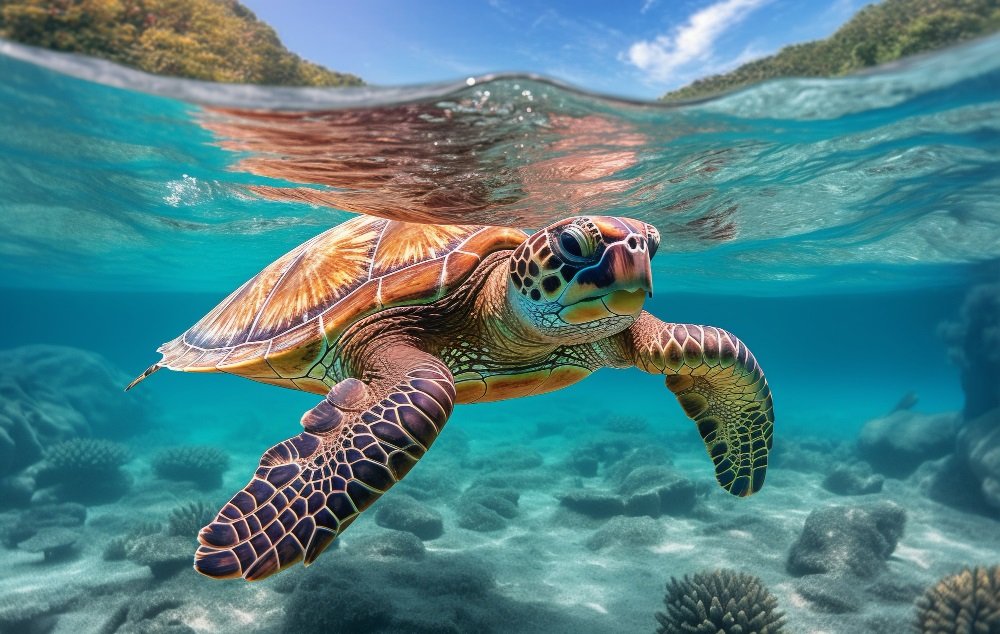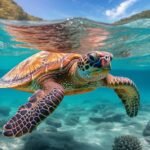Understanding why sea turtles ingest plastic is crucial for their conservation. These magnificent creatures, vital to the health of our oceans, are increasingly encountering plastic debris in their natural habitats. Mistaking plastic for their usual food sources, sea turtles suffer from a range of health problems, ultimately threatening their survival.
The Problem of Plastic Pollution
Plastic pollution is a global crisis, with vast amounts of plastic waste ending up in our oceans. Sea turtles, with their filter-feeding habits and tendency to mistake floating debris for jellyfish, are particularly vulnerable to ingesting plastic.
Why Sea Turtles Eat Plastic
Several factors contribute to sea turtles consuming plastic:
*
Visual Mimicry: Plastic bags, especially those resembling jellyfish, can be visually enticing to sea turtles, who rely heavily on sight to locate prey.
*
Texture and Smell: The texture and smell of some plastics can also resemble natural food sources, further confusing sea turtles.
*
Hunger and Availability: In areas with high plastic pollution, turtles may be more likely to consume plastic simply because it is readily available and they are hungry. (See Also: How Do Turtles See)
Why Do Sea Turtles Eat Plastic?
Sea turtles, majestic creatures that have roamed our oceans for millions of years, are facing a grave threat: plastic pollution. These ancient mariners often mistake plastic debris for their natural food sources, leading to a range of devastating consequences. Understanding why sea turtles eat plastic is crucial to addressing this global crisis and protecting these vulnerable animals.
The Mistaken Identity
Sea turtles have evolved over millennia to feed on a specific diet of jellyfish, crabs, sponges, and other marine organisms. Plastic debris, with its various shapes, sizes, and colors, often resembles these natural prey items. This visual similarity, coupled with the turtles’ instinct to consume anything that appears edible, leads to accidental ingestion.
Similarities to Natural Prey
- Jellyfish: Plastic bags, especially those with thin, translucent material, can closely resemble jellyfish, a staple food for many sea turtle species.
- Squid and Octopus: Pieces of plastic, particularly those with tentacles or appendages, can mimic the appearance of squid or octopus, further confusing sea turtles.
- Seaweed and Algae: Plastic fragments, especially those with a green or brown hue, can be mistaken for seaweed or algae, which turtles often graze on.
The Consequences of Ingestion
Once ingested, plastic can have a devastating impact on sea turtles. The hard, indigestible nature of plastic can cause a variety of problems, ranging from minor discomfort to fatal consequences.
Physical Blockages
Plastic debris can accumulate in a sea turtle’s digestive system, causing blockages that prevent the passage of food. This can lead to starvation, even if the turtle has consumed other food sources.
Internal Injuries
Sharp edges of plastic fragments can lacerate a turtle’s internal organs, causing pain, infection, and internal bleeding.
False Satiation
Sea turtles may feel full after consuming plastic, leading to a decrease in their intake of nutritious food. This can result in malnutrition and weakened immune systems.
The Global Impact
Plastic pollution is a global issue, affecting sea turtles in all oceans. The consequences of plastic ingestion extend beyond individual animals, impacting entire populations and ecosystems.
Population Decline
Sea turtle populations are already threatened by habitat loss, climate change, and fishing bycatch. Plastic pollution adds another layer of stress, contributing to population decline and even local extinctions. (See Also: How Long Do Sea Turtles Migrate)
Ecosystem Disruption
Sea turtles play a vital role in maintaining healthy marine ecosystems. Their decline due to plastic pollution can have cascading effects on other species and the overall health of the ocean.
What Can Be Done?
Addressing the problem of sea turtle plastic ingestion requires a multi-faceted approach involving individuals, communities, and governments.
Reduce Plastic Consumption
One of the most effective ways to protect sea turtles is to reduce our reliance on single-use plastics. Choosing reusable bags, bottles, and containers can significantly reduce plastic waste.
Proper Waste Disposal
It is crucial to dispose of plastic waste responsibly, ensuring that it does not end up in the ocean. This includes using recycling bins, participating in beach cleanups, and supporting initiatives that promote proper waste management.
Support Conservation Efforts
Supporting organizations dedicated to sea turtle conservation is essential. These organizations work to protect nesting beaches, rescue injured turtles, and raise awareness about the threats they face.
Advocate for Policy Change
Urging governments to implement policies that reduce plastic production, promote recycling, and hold polluters accountable is crucial to tackling this global issue.
Conclusion
The ingestion of plastic by sea turtles is a tragic consequence of our reliance on this pervasive material. By understanding the reasons behind this behavior and taking action to reduce plastic pollution, we can help protect these magnificent creatures and the health of our oceans for generations to come.
Sea turtles are vital to the health of our oceans, and their survival depends on our collective efforts to address the plastic crisis. By making conscious choices, supporting conservation initiatives, and advocating for policy change, we can create a future where sea turtles can thrive in a clean and healthy ocean environment. (See Also: How Long Do Cooter Turtles Live)
Why Do Sea Turtles Eat Plastic?
What do sea turtles mistake plastic for?
Sea turtles often mistake plastic debris for their natural food sources, such as jellyfish, seaweed, and sponges. The shape, color, and texture of plastic can closely resemble these prey items, leading to accidental ingestion.
Why is plastic harmful to sea turtles?
Plastic cannot be digested by sea turtles. It can accumulate in their stomachs, causing a false sense of fullness and leading to starvation. Plastic can also block their digestive tracts, resulting in internal injuries and death.
What types of plastic are most dangerous to sea turtles?
Small plastic fragments, such as microplastics, pose the greatest threat to sea turtles. These tiny pieces can easily be ingested and can accumulate in their tissues, causing long-term health problems.
How can we reduce the amount of plastic that sea turtles ingest?
Reducing our reliance on single-use plastics, properly disposing of plastic waste, and supporting organizations that work to clean up plastic pollution are all important steps in protecting sea turtles from ingesting plastic.
What should I do if I find a sea turtle entangled in plastic?
If you encounter a sea turtle entangled in plastic, do not attempt to remove it yourself. Contact your local wildlife authorities or a marine rescue organization for assistance. They have the expertise and equipment to safely disentangle the turtle.


